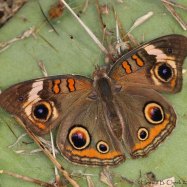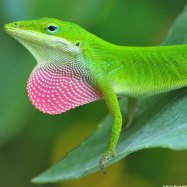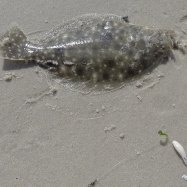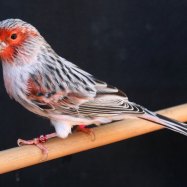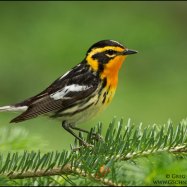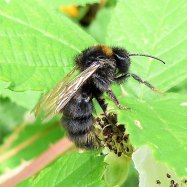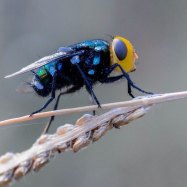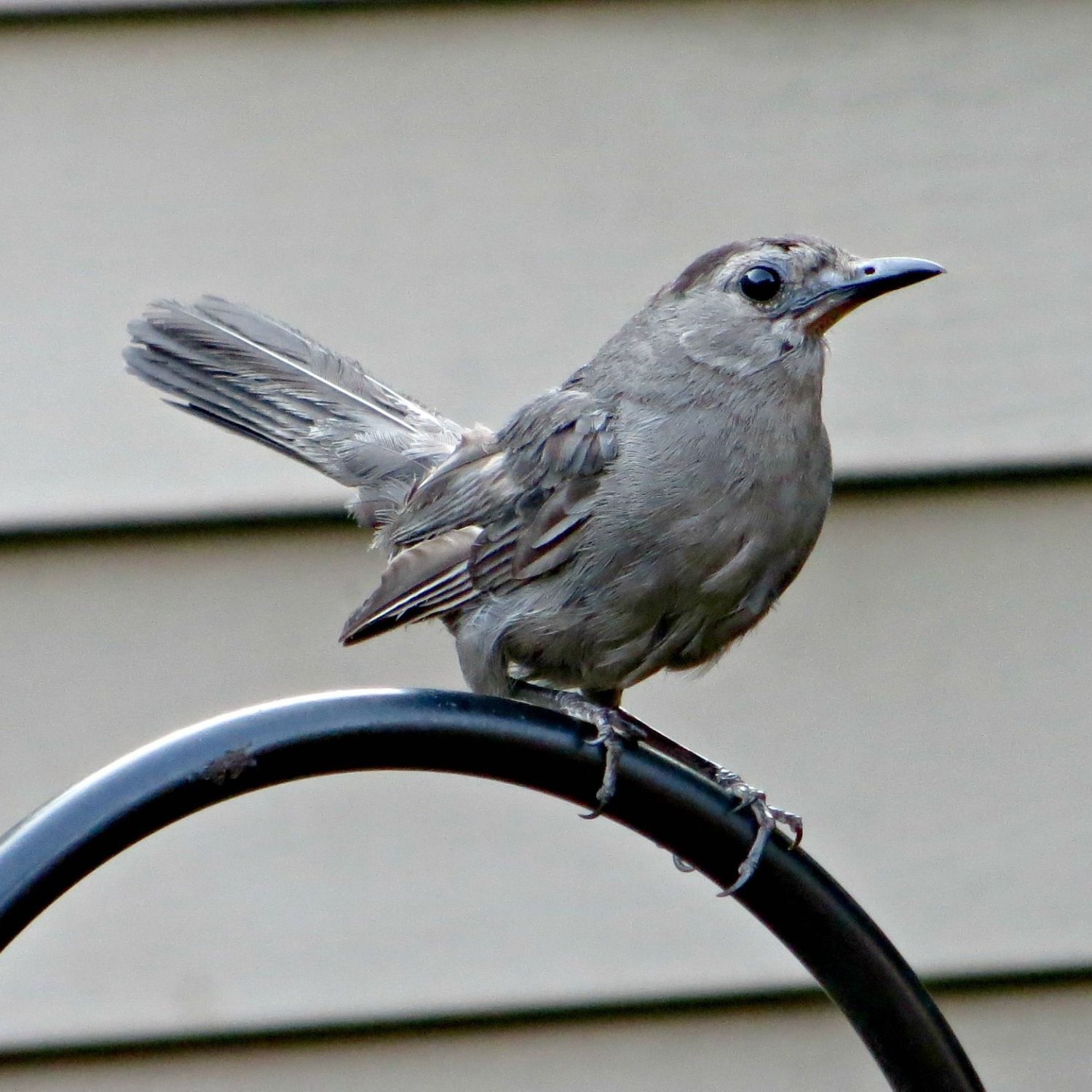
Gray Catbird
8 - 9 inches (20 - 23 cm)
The Gray Catbird, found in eastern and central North America, is a medium-sized songbird known for its distinct gray color and loud vocalizations. Measuring 8-9 inches in length, they belong to the Mimidae family and are often seen hopping and foraging for food on the ground. Keep an eye out for this charming bird next time you're in their habitat! #GrayCatbird #NorthAmerica #Songbird
Animal Details Summary:
Common Name: Gray Catbird
Kingdom: Animalia
Habitat: Woodlands, thickets, gardens
The Charming Gray Catbird: A Master Mimic in the Woodlands of North America
Bird-watching enthusiasts and nature lovers, get ready to be charmed by the charismatic Gray Catbird! With its elegant gray coloration, striking black cap, and unique cat-like calls, this medium-sized songbird is a delightful addition to any backyard or woodland environment.Scientifically known as Dumetella carolinensis, the Gray Catbird is a member of the Mimidae family and is closely related to other mockingbirds and thrashers. But what makes this seemingly ordinary bird stand out is its incredible ability to mimic various sounds, ranging from other bird calls to human noises.
In this article, we'll take a closer look at the interesting features and behaviors of the Gray Catbird, from its physical appearance to its habitat and feeding habits Gray Catbird.
Physical Characteristics
Measuring 8-9 inches (20-23 cm) in length, the Gray Catbird is slightly larger than a sparrow and has a plump, round body shape. As its name suggests, it is mostly gray in color, with a black cap on its head and a small patch of rusty-red feathers under its tail. It also has a long, dark tail, which it often flicks back and forth while foraging.The Gray Catbird somewhat resembles its close relative, the Northern Mockingbird, but can be easily distinguished by its overall gray coloration and the lack of white wing patches. The female Gray Catbird is slightly duller in color compared to the male, but both have the same striking black cap.
Habitat and Distribution
The Gray Catbird can be found all across eastern and central North America, from southern Canada to the Gulf Coast. It is a migratory bird, with breeding populations in the eastern United States and wintering populations in the southern United States and Central America.These birds prefer to live in woodlands, thickets, and shrublands, where they can find plenty of cover and vegetation to hide and build their nests. They are also commonly found in backyard gardens, especially those with dense vegetation and shrubs Gorgosaurus.
Feeding Habits
The Gray Catbird is an omnivorous bird, meaning it feeds on both insects and fruits. Insects make up the majority of their diet, and they often forage on the ground, flipping leaves and stones in search of tasty treats. They are also skilled at catching insects on the fly, thanks to their agile and acrobatic flight.But perhaps what makes the Gray Catbird stand out from other birds is its fondness for fruits and berries. They have a particular love for berries, and during the breeding season, they can often be seen gorging on fruits to regurgitate and feed their young.
This unique feeding habit not only adds a beautiful splash of color to their diet but also plays a vital role in seed dispersal, making them important contributors to the plant ecosystem.
Songs and Sounds
As mentioned earlier, the Gray Catbird is a master mimic and can imitate a wide range of sounds, including other bird calls, human voices, and even the sound of a creaky gate or car alarm. They often incorporate these sounds into their complex and melodic songs, which can go on for several minutes.The Gray Catbird also has a distinctive cat-like call, which is where it gets its name from. This sound is often compared to the mewing of a cat, but it is distinct enough to be recognized as a unique bird call.
Besides vocalization, Gray Catbirds also communicate through visual displays, such as spreading their wings and fanning their tails in a threat display when defending their territory.
The Importance of Mimicry
The ability to mimic sounds has evolved as a survival mechanism for the Gray Catbird. By imitating other birds, they can confuse potential predators and attract potential mates with their impressive repertoire of songs. They also use mimicry during territorial disputes, trying to outdo their neighbors by mimicking their songs.Mimicry is essential for the survival of the Gray Catbird, as it allows them to adapt and thrive in different environments. As their natural habitats continue to be threatened by human activities, their mimicry skills can help them find new food sources and adapt to changing environments.
In Conclusion
The Gray Catbird may seem like an ordinary bird at first glance, but upon closer inspection, its unique features and behaviors make it a fascinating and charming species. From its gray coloration and black cap to its incredible mimicry and fruit-loving diet, it is a bird that is sure to captivate and entertain bird-watchers and nature enthusiasts alike.As we continue to appreciate the beauty and wonder of nature, it is important to protect and preserve the habitats of these magnificent creatures, such as the Gray Catbird, so that they can continue to thrive and enchant us for generations to come.

Gray Catbird
Animal Details Gray Catbird - Scientific Name: Dumetella carolinensis
- Category: Animals G
- Scientific Name: Dumetella carolinensis
- Common Name: Gray Catbird
- Kingdom: Animalia
- Phylum: Chordata
- Class: Aves
- Order: Passeriformes
- Family: Mimidae
- Habitat: Woodlands, thickets, gardens
- Feeding Method: Omnivorous
- Geographical Distribution: North America
- Country of Origin: United States
- Location: Eastern and central North America
- Animal Coloration: Gray overall with a black cap and tail
- Body Shape: Medium-sized songbird
- Length: 8 - 9 inches (20 - 23 cm)
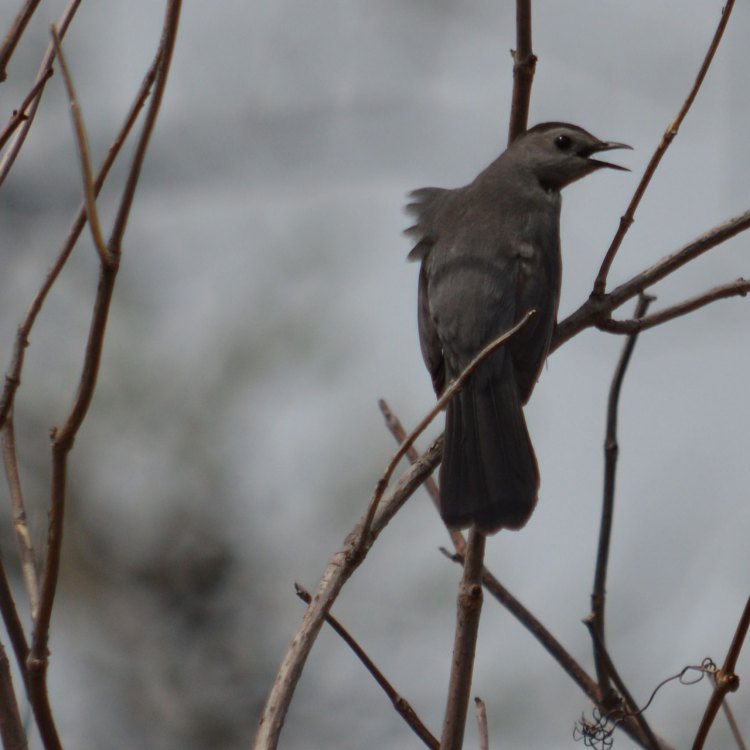
Gray Catbird
- Adult Size: Small
- Average Lifespan: 3 - 10 years
- Reproduction: Monogamous
- Reproductive Behavior: Nests are built by females, both parents incubate the eggs
- Sound or Call: Known for its cat-like mewing call
- Migration Pattern: Migratory, winters in the southern United States and Central America
- Social Groups: Solitary or in small groups
- Behavior: Shy and secretive
- Threats: Habitat loss, predation, and climate change
- Conservation Status: Least Concern
- Impact on Ecosystem: Helps control insect populations
- Human Use: Popular bird among birdwatchers
- Distinctive Features: Black cap and tail, slate gray plumage
- Interesting Facts: Known for its ability to mimic other bird songs
- Predator: Birds of prey, snakes, and domestic cats
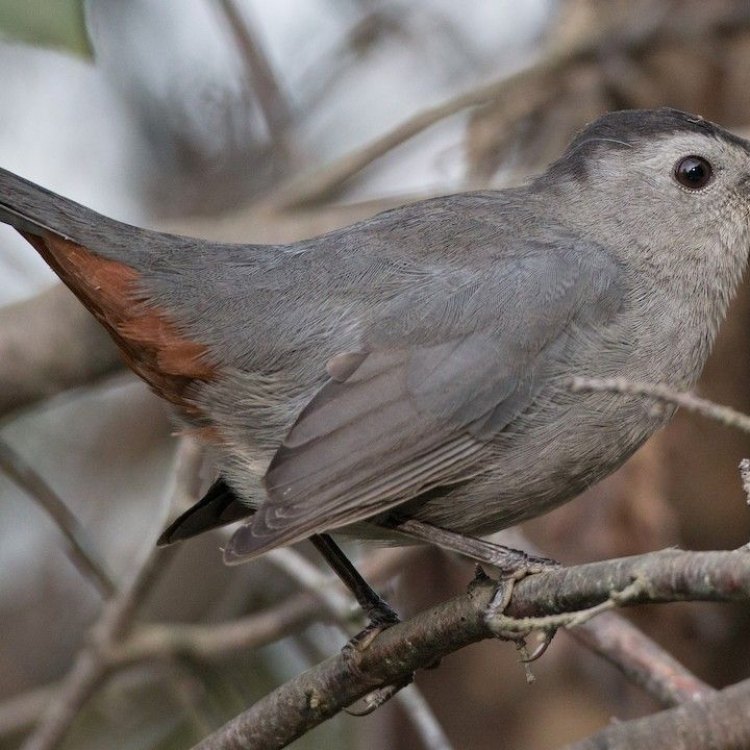
Dumetella carolinensis
The Secret Life of the Gray Catbird: A Master of Mimicry and a Hidden Hero of the Ecosystem
The Gray Catbird may seem like an ordinary and unremarkable bird at first glance. With its small size and muted gray plumage, it can easily blend into its surroundings and go unnoticed. But don't be fooled by its unassuming appearance, as this bird has a secret life full of interesting behaviors, distinctive features, and an important role in the ecosystem.Adult Size and Average Lifespan
The Gray Catbird (Dumetella carolinensis) is a small bird, measuring around 8 inches in length and weighing about 1 PeaceOfAnimals.Com.5 ounces. Its wingspan is typically between 9-12 inches, making it a relatively small bird in comparison to other songbirds.
In terms of lifespan, Gray Catbirds have a wide range with some individuals living up to 10 years, while others only live for three years. This variation in lifespan can be attributed to factors such as predation, habitat quality, and food availability.
Reproduction and Monogamy
Gray Catbirds are monogamous, meaning that they mate with one partner for the entire breeding season. This is a common reproductive behavior among songbirds, but what sets the Gray Catbird apart is the responsibility that both parents take in raising their young.
Female Gray Catbirds are the primary nest builders, using twigs, grass, and other materials to create a small and sturdy cup-shaped nest. Both male and female Gray Catbirds incubate the eggs, which typically hatch after 12-14 days. Once the chicks hatch, both parents take turns feeding and caring for the young until they fledge after 10-12 days Golden Tortoise Beetle.
Sound or Call: The Catbird's Special Talent
One of the most distinctive features of the Gray Catbird is its call. As the name suggests, this bird is known for its cat-like mewing call, which is a series of short, high-pitched notes. This call is used for communication among individuals and is also a territorial and breeding display.
But what sets the Gray Catbird apart from other birds is its ability to mimic the songs and calls of other bird species. It can imitate the songs of more than 50 different bird species, making it a true master of mimicry. And while the reason for this mimicry is still not fully understood, it is believed that it may help the bird attract a mate, defend its territory, or confuse predators.
Migration Pattern and Social Groups
Gray Catbirds are migratory birds, spending their summers breeding in the northern United States and Canada, and then flying south to spend their winters in the southern United States and Central America. They usually begin their migration toward the end of September and can cover a distance of up to 6000 miles.
In terms of social groups, Gray Catbirds are usually solitary or can be found in small groups during the breeding season. They are territorial birds, especially during the breeding season, and will defend their territory from intruders.
Behavior: Shy, Secretive, and a Hidden Gem for Birdwatchers
Gray Catbirds are known for their shy and secretive behavior, often spending a lot of time hidden within the underbrush. They are also quite elusive and can be difficult to spot, making them a hidden gem for birdwatchers.
But for those who do catch a glimpse of these elusive birds, they are in for a treat. Gray Catbirds are known for their beautiful vocalizations, and birdwatchers often seek them out for their unique songs and calls. They are also quite active and agile, hopping and fluttering around branches and shrubs in search of food.
Threats and Conservation Status
Like many other birds, the Gray Catbird faces several threats in the wild. Habitat loss, due to deforestation and urbanization, is one of the biggest threats facing this species. This loss of habitat leads to a decline in food sources and nesting sites, which can have a negative impact on the bird's population.
Predation is also a major threat for the Gray Catbird. Birds of prey, such as hawks and owls, and snakes are natural predators of this species. Additionally, domestic cats are also a threat to these birds, as they can prey on both adults and young.
Despite these threats, the Gray Catbird is currently listed as Least Concern on the IUCN Red List. This is due to their relatively stable population and wide distribution across North America.
Impact on Ecosystem: A Hidden Hero for Controlling Insect Populations
While the Gray Catbird may seem like a small and insignificant bird, it plays a crucial role in its ecosystem. As omnivores, these birds feed on a variety of insects, fruits, and berries. This includes insects that are considered pests to humans, such as caterpillars and beetles.
By consuming these insects, the Gray Catbird helps control their population, making them a natural pest control agent. This is not only beneficial for plants and crops but also for human health, as some of these insects can carry diseases.
Human Use: The Popular Bird of Birdwatchers
As mentioned earlier, the Gray Catbird is a popular bird among birdwatchers. Its beautiful vocalizations, unique behaviors, and elusive nature make it a sought-after species for birdwatchers. In fact, many birding enthusiasts travel long distances just for a chance to spot this elusive bird in the wild.
Distinctive Features: Black Cap and Tail, Slate Gray Plumage
While the Gray Catbird may have a subtle appearance overall, it does have some distinctive features that make it stand out. Its black cap and tail are the most notable, adding a contrast to its slate gray plumage. These features are more prominent in males, making them more easily identifiable.
Interesting Facts: Mimicking Other Bird Songs and Facing Predators
Aside from its ability to mimic other bird songs, the Gray Catbird has other interesting facts that make it a unique species. For example, they often hold their tail upright when perched, giving the appearance of a cat's tail, hence their name.
Gray Catbirds are also quite vocal and have a wide range of vocalizations, with some individuals having over 100 different sounds in their repertoire. They also have an interesting relationship with their predators, as they have been known to follow birds of prey and mob them, calling out loudly to alert other birds of the predator's presence.
Speaking of predators, while the Gray Catbird may face threats from predators, it has also been known to outsmart them. Some individuals have been observed placing snail shells in front of their nest for protection, making it difficult for predators to reach their eggs.
Some Final Thoughts
The Gray Catbird may not be the most well-known or showy bird, but it certainly has a fascinating life full of interesting behaviors, adaptations, and a vital role in the ecosystem. So, the next time you hear a cat-like mewing sound in your backyard, take a moment to appreciate and admire the hidden life of the Gray Catbird.
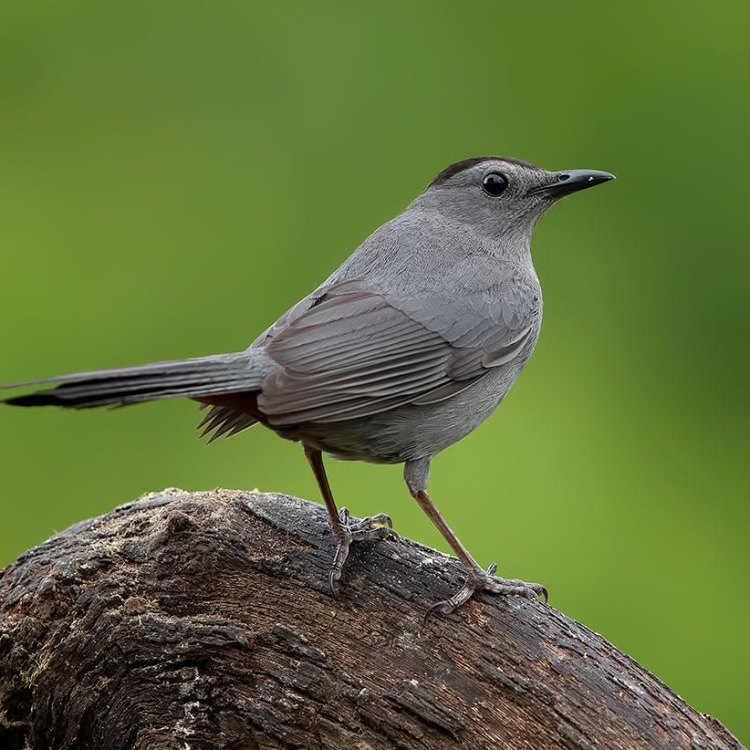
The Charming Gray Catbird: A Master Mimic in the Woodlands of North America
Disclaimer: The content provided is for informational purposes only. We cannot guarantee the accuracy of the information on this page 100%. All information provided here may change without prior notice.

